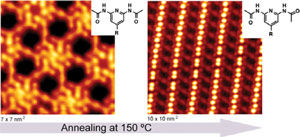Bouncing Bucky Balls
Bucky balls have the moves
C60 molecules have an intriguing ball-shaped structure that suggests several interesting possibilities for motion on surfaces. Indeed, researchers have found that the passage of electrons through a bucky ball in a transistor is correlated to the spinning of the ball around its center of mass. Moreover, since bucky balls look like molecular ball bearings, it has been thought that they may be useful as lubricants for use in automobile brakes. Now a team of researchers at the University of Bologna (Italy) and the University of Liverpool (UK) have carried out detailed molecular dynamics simulations to understand the motion of bucky balls on metal surfaces.
Francesco Zerbetto and Gilberto Teobaldi have found that C60 molecules exhibit a wide range of molecular motions on surfaces. The bucky balls spin and bounce on the surface and also show an intercage rattling motion that Zerbetto says is similar to that of billiard balls in a partly filled roll-a-rack triangle. The simulations have been carried out as a function of temperature and model the movement of several bucky ball molecules over times ranging up to one nanosecond. There is some transfer of charge from the gold surface to the bucky ball that helps in the adsorption of these molecules at the surface. The researchers have found that with increasing temperature the cages move away from the gold surfaces resulting in a lower frequency of bouncing. The bouncing frequencies obtained by simulation match very nicely with experimental measurements of single-molecule bucky-ball transistors, corroborating the validity of the simulations.
The researchers have found that the bouncing of the cage on the surface and the intercage rattling govern the friction-related properties of the bucky balls on a surface. "The strong van der Waals interactions of the bucky balls with neighboring atoms makes the friction far too high for lubrication", said Zerbetto, but he is hopeful that doping or chemical modification can be used to separate the bucky balls to get them to act more like ball bearings.
Original publication: Francesco Zerbetto et al.;"C60 on Gold: Adsorption, Motion, and Viscosity"; Small 2007, 3, No. 10, 1694-1698.
Most read news
Topics
Organizations
Other news from the department science

Get the chemical industry in your inbox
By submitting this form you agree that LUMITOS AG will send you the newsletter(s) selected above by email. Your data will not be passed on to third parties. Your data will be stored and processed in accordance with our data protection regulations. LUMITOS may contact you by email for the purpose of advertising or market and opinion surveys. You can revoke your consent at any time without giving reasons to LUMITOS AG, Ernst-Augustin-Str. 2, 12489 Berlin, Germany or by e-mail at revoke@lumitos.com with effect for the future. In addition, each email contains a link to unsubscribe from the corresponding newsletter.




















































